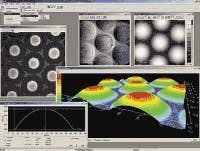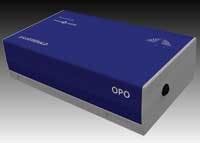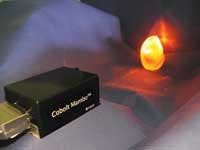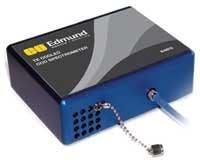Digital holographic microscopes
The DHM R1000 (reflective mode) and T1000 (transmission mode) digital holographic microscopes capture 3-D optical images in real time at up to 50,000 frames per second (fps), and thus eliminate the need for isolation equipment. They claim another advantage over interferometric instruments too: vertical range; they offer lateral resolution down to 300 nm and vertical temporal resolution of 0.2 nm in air. A stroboscopic mode, operating at 25MHz, allows stop-action in the nanosecond range, enabling mapping of movement and the influence of changing variables in real-time. It can generate movies that show changes as variables are modified.
Lyncèe Tec, Lausanne, Switzerland, bioopticsworld.com/articles/368659
Orange laser for fluorescence apps
The Cobolt Mambo is a compact diode-pumped solid-state (DPSS) orange laser designed for fluorescence applications such as confocal microscopy and flow cytometry. An alternative to HeNe lasers, it enables new applications, including excitation of Alex Fluor 594 and mCherry, for instance. The continuous-wave laser in a hermetically sealed, rugged housing operates at 594 nm with an output power of up to 50 mW.
Cobolt AB, Stolna, Sweden, bioopticsworld.com/articles/365868
All-in-one ultrafast CARS light source
A turnkey light source for coherent anti-Stokes Raman-scattering (CARS) microscopy, the picoEmerald is a remote controlled, hands-free one-box unit that promises pump and Stokes pulses perfectly overlapped in space and time. The device comprises a high-power picosecond oscillator (1064 nm) with a frequency doubler and a synchronously pumped optical parametric oscillator (OPO) in a single housing; an active resonator control continuously maximizes efficiency.
APE GmbH, Berlin, Germany; High Q Laser, Watertown, MA, bioopticsworld.com/articles/365865
CCD spectrometers with integrated cooling
Low-cost, high-performance CCD-based spectrometers target low-light-level detection and long-term monitoring applications. The CCD array is cooled using built-in thermoelectric cooler (TEC) to decrease dark noise, improve dynamic range, and provide long-term stability. The units offer 2048 pixels and include a built-in 16-bit digitizer for optimum resolution and maximum flexibility with integration time–plus a high-speed USB 2.0/1.1 interface.
Edmund Optics, Barrington, NJ, bioopticsworld.com/articles/338375



